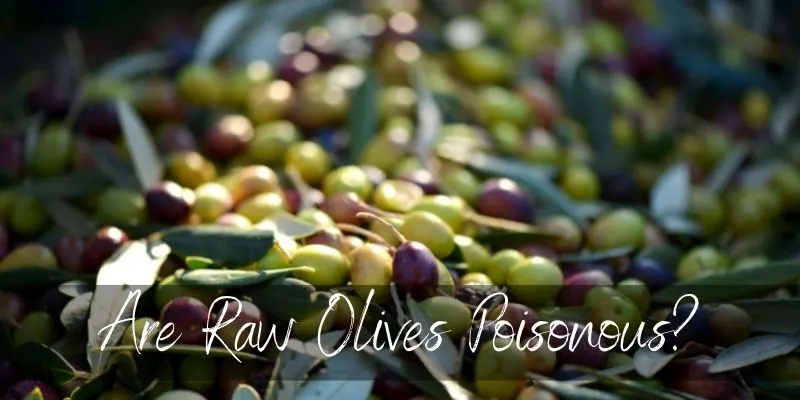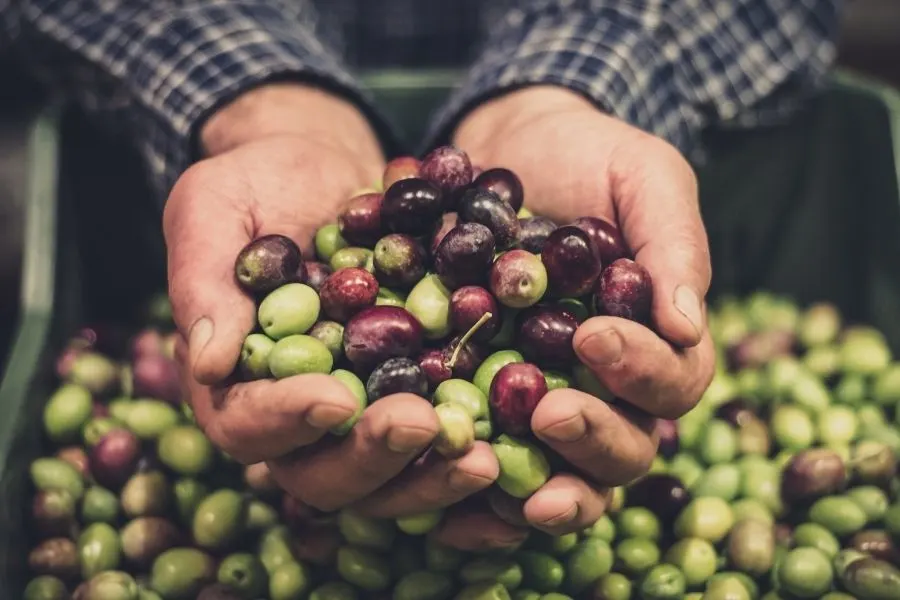Olive trees are not growing in my country, but the first time I saw olive trees on vacation, somebody near me instantly said that the raw olives are poisonous, and I didn’t question it at that time.
But now I decided to do some research to find out if raw olives are really poisonous and also to share with you what I found out.
I believe people are in love with saying about every single raw vegetable, fruit or plant that it is poisonous. I’m very skeptical lately when I hear someone saying that a vegetable is poisonous if eaten raw.
There are a few that you should check if they are safe to eat but not as many as some may think. You can even eat raw eggplant if you want, not that I would recommend it, but it is not poisonous. Meanwhile rhubarb is only poisonous at certain times.
Now let’s get to our topic and find out if it is safe to eat raw olives or are they poisonous if not treated before eating.

Are raw olives poisonous?
Raw untreated olives are not poisonous to the human body, but they are way too bitter because they contain a chemical called oleuropein which has very good anti-microbial properties. It is the olive’s defense mechanism.
It is known that the bitter taste is associated with poison, but that doesn’t mean that everything that is bitter is also poisonous.
So while you will not get sick by eating raw olives, you will not enjoy eating them. All olives are cured before getting to you. This process gets rid of their extreme bitterness and also makes them 100% safe to eat.
Read Also: Can You Eat Raw Okra?
How to cure olives?
There are quite a few ways to cure olives, and each of them has its advantages and disadvantages, which can also impact the taste of the olive.
-Brining. This is the most common way of curing the olives and the easier one to use. You just have to place the olives in salted water, a good ratio of salt to water is 1 to 10.
Let them sit there for two or three months, this depends on how you prefer them, and also change the water once a week.
If you want the olives to be ready to eat faster, removing the pit will significantly reduce the time they need to brine since the salted water will get to the middle of the olive much easier.
-Water curing. While this process is faster than bringing them, it is much more inefficient in removing the bitterness from the olive, and also, the olive will not last as much as the brined ones.
In order to cure olives in water, you have to soak them in a bath for a few weeks, depending on how bitter you want them. This method requires you to change the water much more often, daily if possible.
-Lye curing. This is a method that many companies use because it is much faster than the other ways.
The fact that they are exposed to oxygen also makes green olives go black faster, which is why black olives are cheaper and easier to find on the market.
This method has to be used very carefully, and you must wash the olives several times after lye curing them.
If you are planning to cure olives by yourself, the best way to do this is to brine them. Of course, you need time for that. If you are in a rush, make sure you do more research about curing them with lye since there are a few risks involved, and you want to make sure you get it right.
I have another good article about the reason olives are fermented to help you do further research on this topic.

How to buy good olives?
So we found out that all olives that get to the market are not actually raw straight from the tree.
But let’s see how we can get the best out of the olives we buy. It can be quite hard to choose good olives. They came in cans or jars, and most likely, you don’t have the opportunity to taste them before buying.
There are still a few things you can check before buying them.
-Smell. If they are at the supermarket and they are out of their can or jar, they should smell fresh and watery. Don’t buy them if they have a weird odor or smell rotten.
-Texture. A good olive should be quite firm without any sign of being mushy. It is better to go for the ones that look firmer and without wrinkles.
-Apparence. I don’t mean the color of the olives since they come in many different colors, but most of them will not have discolorations or bruises. Go for the shiny and smooth ones and, of course, avoid the ones that are getting moldy.
-Storage. This applies to the ones that are out of their jars or cans. I noticed that in some supermarkets, they get them out and keep them in the fridge without their juice which is off-putting, at least for me. I’m not sure if it happens anywhere, but where I found them this way was quite a big reputable supermarket, so I would guess that it is often happening.
-Curing method. As we talked about before, the curing method is important when it comes to the taste and texture of the olive. The brined ones should be the best, but they also take the most time to be ready to eat so you can expect them to be a bit more expensive.
Read Also: Why Are Olives So Salty ?
Conclusion
The conclusion is that raw olives are not poisonous, but they are not a pleasure to be eaten this way since they are way too bitter.
I hope this article helped you know how to get the best out of the olives if you have them raw or at least understand the method that was used to cure them before getting to you.

